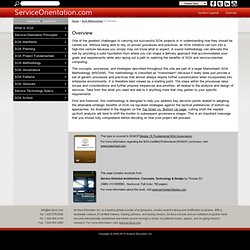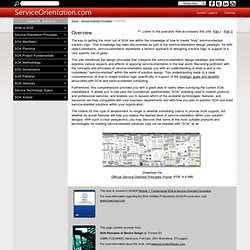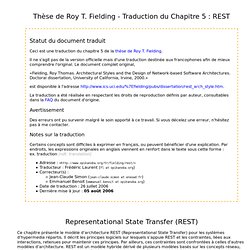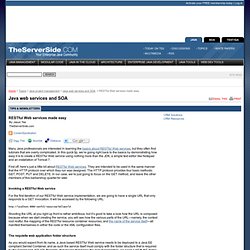

Web Services (Français) SOA Patterns. Soamethodology.com. One of the greatest challenges to carrying out successful SOA projects is in understanding how they should be carried out.

Without being able to rely on proven processes and practices, an SOA initiative can turn into a high-risk venture because you simply may not know what to expect. A sound methodology can alleviate this risk by providing a solid foundation from where you can shape a delivery approach that accommodates your goals and requirements while also laying out a path to realizing the benefits of SOA and service-oriented computing.
The concepts, processes, and strategies described throughout this site are part of a larger Mainstream SOA Methodology (MSOAM). This methodology is classified as "mainstream" because it really does just provide a set of generic processes and practices that almost always require further customization when incorporated into enterprise environments. It is therefore best viewed as a starting point. SOA Principles. Listen to the podcasts that accompany this site: Part I - Part II The key to getting the most out of SOA lies within the knowledge of how to create "truly" service-oriented solution logic.

That knowledge has been documented as part of the service-orientation design paradigm. As with object-orientation, service-orientation represents a distinct approach to designing solution logic in support of a very specific set of goals. This site introduces the design principles that comprise the service-orientation design paradigm and further explores various aspects and effects of applying service-orientation in the real world. Becoming proficient with the concepts and principles of service-orientation equips you with an understanding of what is and is not considered "service-oriented" within the world of solution design. Furthermore, this comprehension provides you with a great deal of clarity when surveying the current SOA marketplace. Thèse de Roy T. Fielding - CHAPITRE 5: Representational State Transfer (REST) Statut du document traduit Ceci est une traduction du chapitre 5 de la thèse de Roy T.

Fielding. Il ne s'agit pas de la version officielle mais d'une traduction destinée aux francophones afin de mieux comprendre l'original. Le document complet original, «Fielding, Roy Thomas. Est disponible à l'adresse La traduction a été réalisée en respectant les droits de reproduction définis par auteur, consultables dans la FAQ du document d'origine. Avertissement Des erreurs ont pu survenir malgré le soin apporté à ce travail. Notes sur la traduction. RESTful resources for potential REST developers. Wikipedia defines Representational State Transfer ( REST ) as "a style of software architecture for distributed hypermedia systems such as the World Wide Web.

" The RESTful approach to Web services is widely seen as a simpler When you register, you'll begin receiving targeted emails from my team of award-winning writers. Our goal is to keep you informed on recent service-oriented architecture (SOA) and SOA-related topics such as integration, governance, Web services, Cloud and more. alternative to SOAP. Many big name Web services providers such as Amazon, Twitter and Google use the RESTful approach extensively. As elucidated by Fielding in his PhD Dissertation in 2000, the principles of RESTful Web services are really rather simple.
Java developers have been evolving the Java API for RESTful Web services or JAX-RS for some time in association with the JSR-311 specification. The Restlet framework was started as an open source project well before the JSR-311 committee got organized. SOA information, news and tips - SearchSOA.com. RESTful Web services made easy. Many Java professionals are interested in learning the basics about RESTful Web services, but they often find tutorials that are overly complicated.

In this quick tip, we’re going right back to the basics by demonstrating how easy it is to create a RESTful Web service using nothing more than the JDK, a simple text editor like Notepad and an installation of Tomcat 7. First off, here’s just a little bit about RESTful Web services. They are intended to be used in the same manner that the HTTP protocol over which they run was designed. The HTTP protocol provides four basic methods: GET, POST, PUT and DELETE. In our case, we’re just going to focus on the GET method, and leave the other members of this barbershop quartet for later Invoking a RESTful Web service For the first iteration of our RESTful Web service implementation, we are going to have a single URL that only responds to a GET invocation.
The requisite web application folder structure +\(root folder) ++WEB-INF\ ++++classes\ ++++lib\